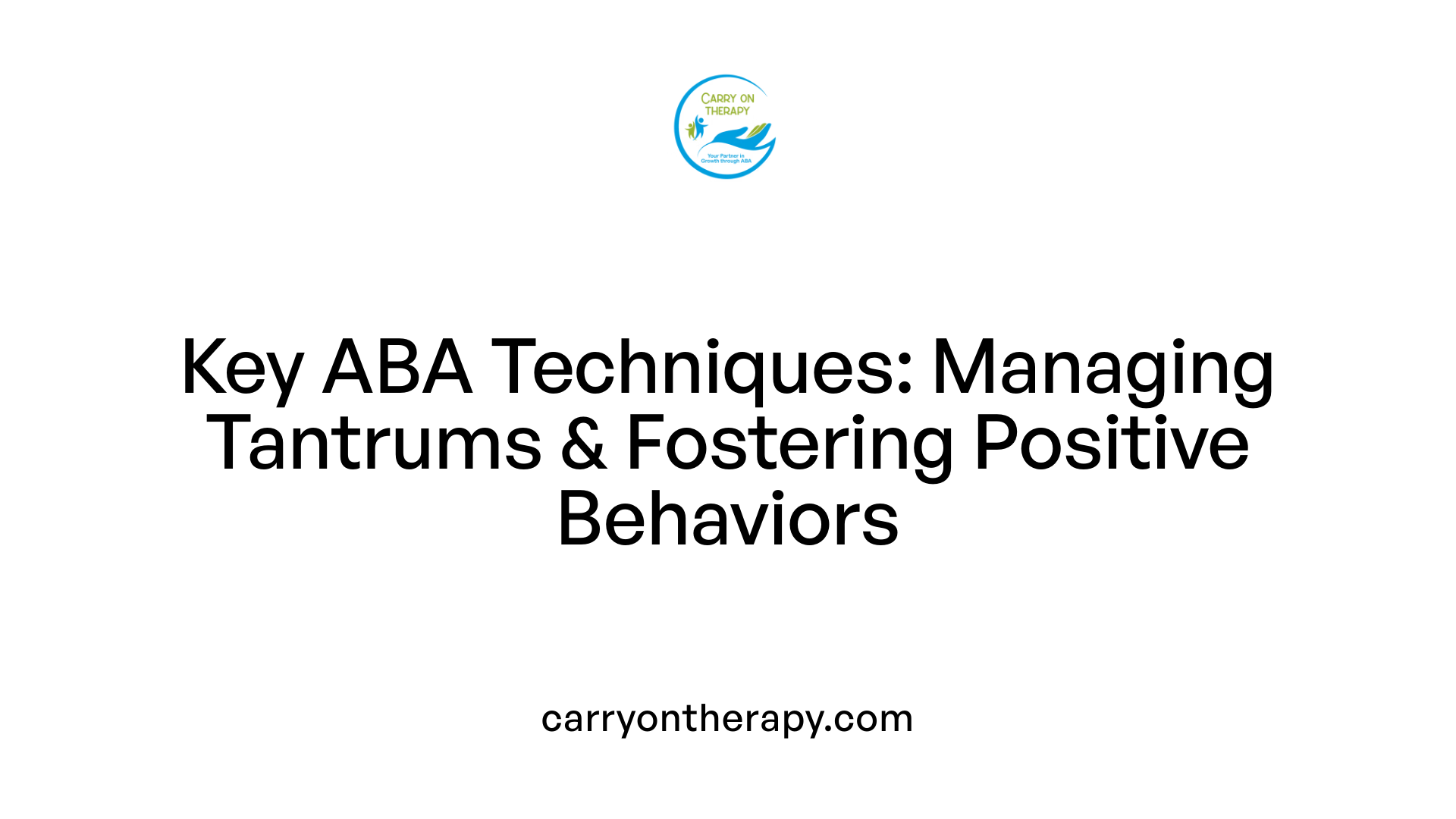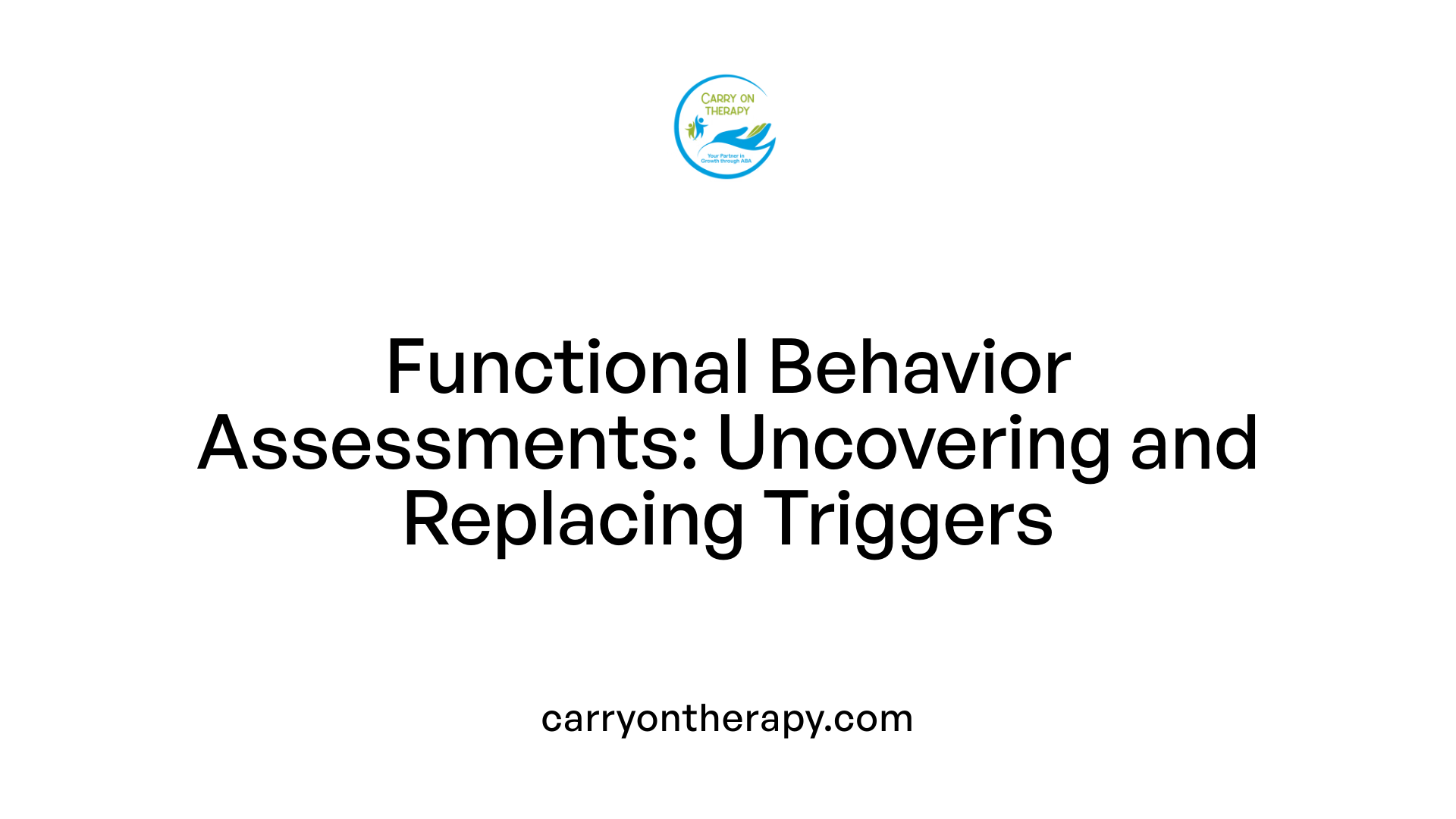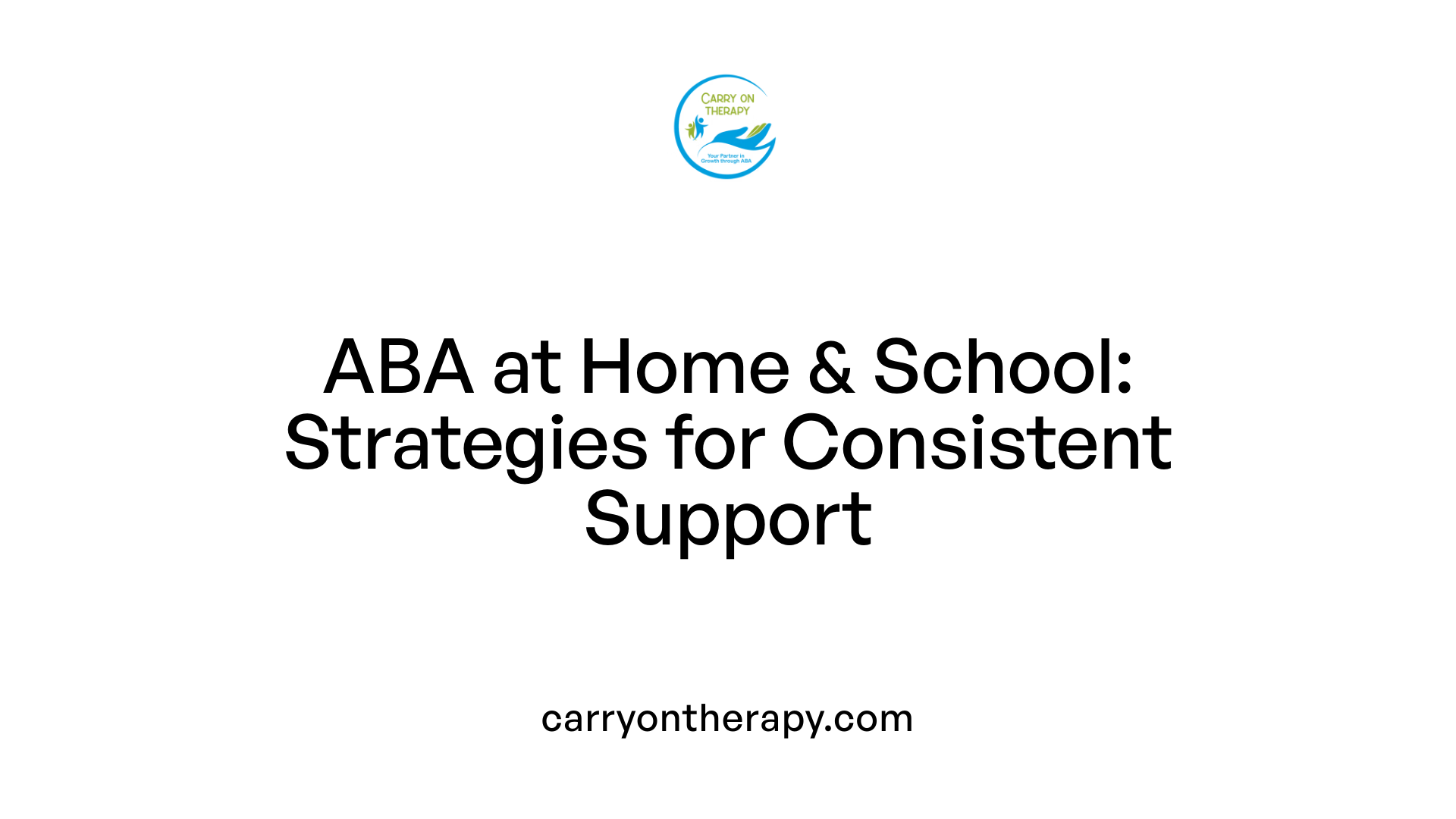Managing Tantrums with ABA
Harnessing the Power of ABA to Calm and Guide: Effective Strategies for Managing Tantrums

Understanding ABA and Its Role in Addressing Challenging Behaviors
Applied Behavior Analysis (ABA) is a scientifically grounded therapy known for its effectiveness in supporting individuals with autism spectrum disorder (ASD), particularly in managing challenging behaviors such as tantrums. By focusing on observable behaviors and the environmental factors influencing them, ABA offers personalized strategies to reduce tantrums and teach alternative, positive behaviors. This article explores the core principles of ABA, its key techniques in behavior management, and how families can access quality ABA services tailored to their needs.
What is ABA Therapy and How Does It Aid Individuals with Autism?

Definition and Scientific Basis of ABA
Applied Behavior Analysis (ABA) therapy is a clinically proven method grounded in the science of learning and behavior. It applies psychological principles, such as operant conditioning, to systematically observe, measure, and modify behaviors. Pioneered by B.F. Skinner and adapted for autism treatment by Dr. Ivar Lovaas in the 1960s, ABA focuses on teaching new skills and reducing challenging behaviors.
How ABA Helps Improve Social, Communication, and Functional Skills
ABA aids individuals with autism by promoting skills in social interaction, communication, daily living, and academics. Through structured teaching methods like Discrete Trial Training (DTT) and Pivotal Response Training (PRT), it breaks down complex tasks into manageable steps and targets pivotal behaviors like motivation and engagement, fostering broad developmental gains.
Use of Positive Reinforcement and Behavior Analysis Techniques
A cornerstone of ABA is positive reinforcement, which rewards desired behaviors to increase their frequency. Utilizing the A-B-Cs model (Antecedent, Behavior, Consequence), ABA professionals analyze triggers and outcomes to modify behaviors effectively. Tools such as Functional Behavior Assessment (FBA) help identify causes of challenging behaviors and replace them with appropriate alternatives.
Personalization and Ongoing Evaluation of ABA Programs
ABA programs are tailored to each individual's developmental level and needs. Certified behavior analysts design personalized treatment plans with clear goals, continual assessments, and data-driven adjustments to ensure progress. Interventions can be comprehensive, involving intensive therapy over months or years, or focused on specific skill areas.
Settings in Which ABA Therapy Can Be Delivered
Flexibility is a hallmark of ABA, which can be implemented across diverse environments including homes, schools, community centers, and workplaces. This adaptability allows therapy to be contextually relevant, promoting skill generalization across different settings.
Long-term and Early-Intervention Benefits
Evidence strongly supports ABA's efficacy, particularly with early and intensive intervention starting as young as age one. Programs delivering 25-40 hours weekly over 1-3 years have shown significant improvements in language, cognitive abilities, social interaction, and daily functioning. Early ABA intervention is linked to enhanced overall developmental outcomes and quality of life.
| Aspect | Description | Example/Application |
|---|---|---|
| Scientific Basis | Learning theory principles applied systematically | Operant conditioning, A-B-Cs model |
| Skill Development | Enhances communication, social, and daily living skills | DTT, PRT, Functional Communication Training |
| Reinforcement Techniques | Positive reinforcement to increase desired behaviors | Reward systems, visual aids |
| Personalization | Individualized treatment plans with ongoing assessment | Tailored goals and strategies |
| Delivery Settings | Wide applicability across home, school, community | In-home therapy, school-based interventions |
| Intervention Timing | Benefits greatest with early and intensive intervention | Long-term programs for toddlers and young children |
Who Provides ABA Therapy? Qualifications and Roles of Professionals

Who provides ABA therapy and what qualifications do professionals typically have?
ABA therapy is delivered by trained professionals such as Board Certified Behavior Analysts (BCBAs) and Registered Behavior Technicians (RBTs).
BCBAs represent the highest level of certification in ABA. They hold graduate-level degrees in behavior analysis or related fields, possess extensive supervised experience, and pass a rigorous certification exam. BCBAs are responsible for designing, overseeing, and adjusting individualized treatment plans based on ongoing data collection and assessment.
RBTs work under the close supervision of BCBAs. They are directly involved in implementing therapy sessions with clients and have specialized training and certification focused on delivering ABA interventions effectively.
Other professionals who may be involved include behavior therapists and educators with targeted skills in autism and behavior-based strategies.
The qualifications and expertise of these providers are critical in ensuring high-quality therapy. Research consistently shows that programs led and supervised by certified professionals yield better outcomes in communication, social behavior, and daily living skills.
Choosing qualified ABA providers not only supports effective intervention but also ensures consistent application of best practices tailored to individual client needs.
Core ABA Techniques for Managing Tantrums and Encouraging Positive Behaviors

What are some common techniques used in ABA therapy for autism?
ABA therapy employs several structured strategies to manage behaviors like tantrums and encourage positive actions, adapting to the individual's needs.
Discrete Trial Training (DTT) breaks skills into small, manageable steps. Each trial consists of a clear instruction, a response from the individual, and a consequence such as positive reinforcement for correct answers, helping build desired behaviors through repetition.
Natural Environment Teaching occurs in everyday settings, promoting learning in real-life contexts. This helps individuals generalize skills beyond therapy sessions, encouraging spontaneous communication and social interaction.
Functional Behavior Assessment (FBA) identifies the triggers or causes of specific behaviors, such as tantrums. By understanding the 'why' behind behaviors, ABA therapists develop interventions that replace problematic behaviors with appropriate alternatives.
Positive Reinforcement and Prompting are central in encouraging behaviors. Positive reinforcement rewards desired actions, increasing their frequency. Prompting provides cues or assistance to initiate behaviors, which is gradually faded to encourage independence.
Visual aids and communication systems, including Picture Exchange Communication System (PECS) and Functional Communication Training (FCT), help individuals express needs and desires, significantly reducing frustration-driven behaviors.
Behavior Chaining sequences complex behaviors into smaller steps, teaching each link until the entire chain is learned. This is particularly helpful in teaching daily living skills.
The ABA 'A-B-Cs' model (Antecedent, Behavior, Consequence) is used to analyze what happens before and after a behavior, enabling precise interventions tailored to each situation.
These combined techniques create comprehensive, consistent behavior management plans aimed at enhancing communication, social skills, and overall independence, significantly benefiting individuals with autism and their families.
Functional Behavior Assessment: Identifying and Replacing Tantrum Triggers

What Is the Purpose of Functional Behavior Assessment (FBA)?
Functional Behavior Assessment is a process used in Applied Behavior Analysis to understand the reasons behind specific behaviors, such as tantrums. The main goal of FBA is to identify the triggers and outcomes that maintain a behavior, enabling practitioners and caregivers to develop effective intervention strategies.
How Does FBA Identify Antecedents, Behaviors, and Consequences?
FBA systematically observes and records what happens before (antecedents) and after (consequences) a behavior to determine why the behavior occurs. By examining these factors, it helps pinpoint situational triggers and reinforcers that sustain the tantrums.
How Is the ABA 'A-B-Cs' Model Applied in Behavior Understanding?
The ABA 'A-B-Cs' model—Antecedent, Behavior, Consequence—forms the foundation of FBA. It guides professionals to analyze the context around tantrums by asking:
- What happens right before the tantrum?
- What exactly is the tantrum behavior?
- What follows the tantrum that reinforces it?
This systematic approach aids in identifying patterns that cause or maintain challenging behaviors.
How Do Strategies Replace Tantrums With Appropriate Behaviors?
Following FBA, tailored interventions focus on teaching alternative behaviors that serve the same function as the tantrum. For example, if a tantrum is used to request attention, Functional Communication Training (FCT) might teach the individual to ask appropriately instead. Consistently reinforcing these alternative behaviors helps reduce the occurrence of tantrums.
What Is the Role of Data Collection and Ongoing Evaluation?
Continuous data collection during and after intervention is essential to assess effectiveness and ensure that behavior changes are directly linked to the intervention. Ongoing evaluation allows adjustments to strategies, promoting lasting improvements in behavior.
Accessing ABA Therapy Services: What Families Should Know
Finding ABA therapy for children with autism
Families seeking ABA therapy often start by consulting healthcare professionals who can provide referrals. Insurance providers, including Medicaid and various private plans, frequently cover ABA services when prescribed as medically necessary. This coverage helps make therapy more accessible for many families.
Insurance coverage and referral pathways
Before beginning ABA therapy, it's essential to verify whether your insurance plan includes ABA benefits and understand any referral requirements. Some programs require a formal diagnosis and a referral from a pediatrician or developmental specialist to qualify for coverage.
Evaluating provider credentials and program quality
Quality ABA programs employ qualified professionals such as Board Certified Behavior Analysts (BCBAs) and Registered Behavior Technicians (RBTs). Families should confirm credentials, experience, and ask about the provider’s adherence to ethical standards. Accreditation from organizations like the Behavioral Health Center of Excellence (BHCOE) can be a helpful quality indicator.
Importance of individualized, data-driven treatment plans
Effective ABA therapy follows a personalized, data-driven approach. Programs should tailor goals based on comprehensive assessments and continuously track progress through objective measurement. Clear definitions of target behaviors and scientific strategies ensure interventions meet each child's unique needs.
Ensuring family involvement and clear communication
Active family participation is vital for success. Providers should offer training and resources so parents can reinforce learning at home. Transparent communication about therapy methods, progress reports, costs, and transition plans builds trust and supports collaboration.
Ethical considerations and safety in therapy settings
Safety and ethical conduct are priorities during ABA therapy. Families should inquire about protocols that protect the child’s well-being and ensure respectful, positive interactions within therapy environments.
Selecting an ABA provider involves assessing qualifications, program philosophy, and the quality of care provided. With these factors considered, families can support their child’s development through an effective, evidence-based therapy tailored to their individual needs.
Benefits of Early and Intensive ABA Intervention in Managing Challenging Behaviors

Why is early intensive behavioral intervention (EIBI) important?
Early intensive behavioral intervention (EIBI) plays a crucial role in supporting individuals with autism spectrum disorder, especially when started as early as age one. By delivering comprehensive therapies that target communication, social skills, daily living, and academics, EIBI helps set a strong foundation for future development.
How long is the therapy commitment and how often are sessions?
EIBI typically involves a long-term commitment spanning one year or more. Sessions are intensive, often provided multiple times per week totaling between 25 to 40 hours weekly. This sustained approach, commonly conducted in home, school, or center settings, ensures consistent learning and skill acquisition.
What impact does EIBI have on reducing challenging behaviors?
Focused ABA interventions within EIBI are effective at decreasing challenging behaviors such as tantrums, aggression, and self-injury. Through strategies like functional behavior assessment, therapists identify behavior triggers and teach appropriate replacement behaviors, yielding significant reductions in problem behaviors.
What improvements are seen in communication, social, academic, and daily living skills?
EIBI supports notable enhancements across key areas including communication, social interactions, academic performance, and practical daily living skills. Techniques like discrete trial training and pivotal response training foster new skills, empowering individuals to engage more fully with family, school, and community.
What research supports the outcomes of early ABA intervention?
Research with over 20 studies demonstrates that early, intensive ABA intervention leads to superior outcomes relative to other treatments. Evidence supports gains in intellectual functioning, language, social abilities, and independence, emphasizing that early, consistent ABA therapy maximizes developmental progress.
| Aspect | Details | Importance |
|---|---|---|
| Early Start | Therapy can begin as early as age 1 | Harnesses brain plasticity for best gains |
| Therapy Duration & Frequency | 25-40 hours per week for 1-3 years | Ensures sufficient practice and mastery |
| Behavior Improvements | Decreased tantrums, aggression, and self-injury | Enhances quality of life and safety |
| Skill Development | Communication, social, academic, daily living skills | Promotes independence and social inclusion |
| Research Evidence | 20+ studies affirm effectiveness | Validates EIBI as best practice |
Integrating ABA Strategies at Home and School to Support Behavior Management

How Can Parents Use ABA Strategies at Home?
Parents play a critical role in supporting learning and behavior through ABA strategies. Positive reinforcement is commonly used, where desirable behaviors are rewarded to encourage their repetition. Visual schedules help children understand daily routines and expectations, promoting consistency and reducing anxiety.
What ABA Techniques Are Used in Classroom Settings?
In schools, ABA creates structured environments that promote skill-building and positive behaviors. Techniques include using rewards to reinforce good behavior, visual cues to guide students, and individualized plans tailored to each child’s needs. These approaches help manage behaviors and support learning.
Why Is Collaboration Important Among Therapists, Families, and Educators?
Effective ABA implementation requires collaboration among behavior analysts, parents, and teachers. This partnership ensures strategies are consistent across settings, which is essential for reinforcing behaviors and generalizing skills.
How Are Communication Tools Like PECS and Functional Communication Training Used?
Tools such as the Picture Exchange Communication System (PECS) and Functional Communication Training (FCT) assist children in expressing needs and reducing challenging behaviors. These methods provide alternative, positive ways for communication, enhancing social interaction both at home and school.
Why Are Consistency and Caregiver Involvement Crucial?
Research shows that success in ABA interventions depends heavily on consistency and active caregiver involvement. When families and educators consistently apply ABA principles, children benefit from stable learning environments, which leads to better outcomes in communication, social skills, and daily living abilities.
The Transformative Impact of ABA in Managing Tantrums
Applied Behavior Analysis presents a comprehensive, evidence-based framework for understanding and reducing tantrums among individuals with autism. Through scientifically supported techniques, personalized interventions, and collaborative care involving families and professionals, ABA therapy fosters meaningful improvements in communication, social functioning, and daily living skills. Early and consistent ABA intervention, delivered by qualified and compassionate practitioners, empowers individuals to replace challenging behaviors with effective alternatives, enhancing their quality of life. By embracing ABA strategies across home, school, and community environments, families can build supportive pathways for managing tantrums and promoting positive developmental outcomes.
References
- What are ABA interventions?
- What are ABA Therapy Techniques and How are They Used?
- Everything You Need to Know About ABA Therapy
- Applied Behavior Analysis (ABA)
- Who Qualifies for ABA Therapy: Eligibility Guide
- ABA Techniques: Strategies for Behavior Analysts - GSEP Blog
- ABA Therapy Examples, Definition & Techniques
- Applied Behavior Analysis (ABA)
- Treatment and Intervention for Autism Spectrum Disorder







